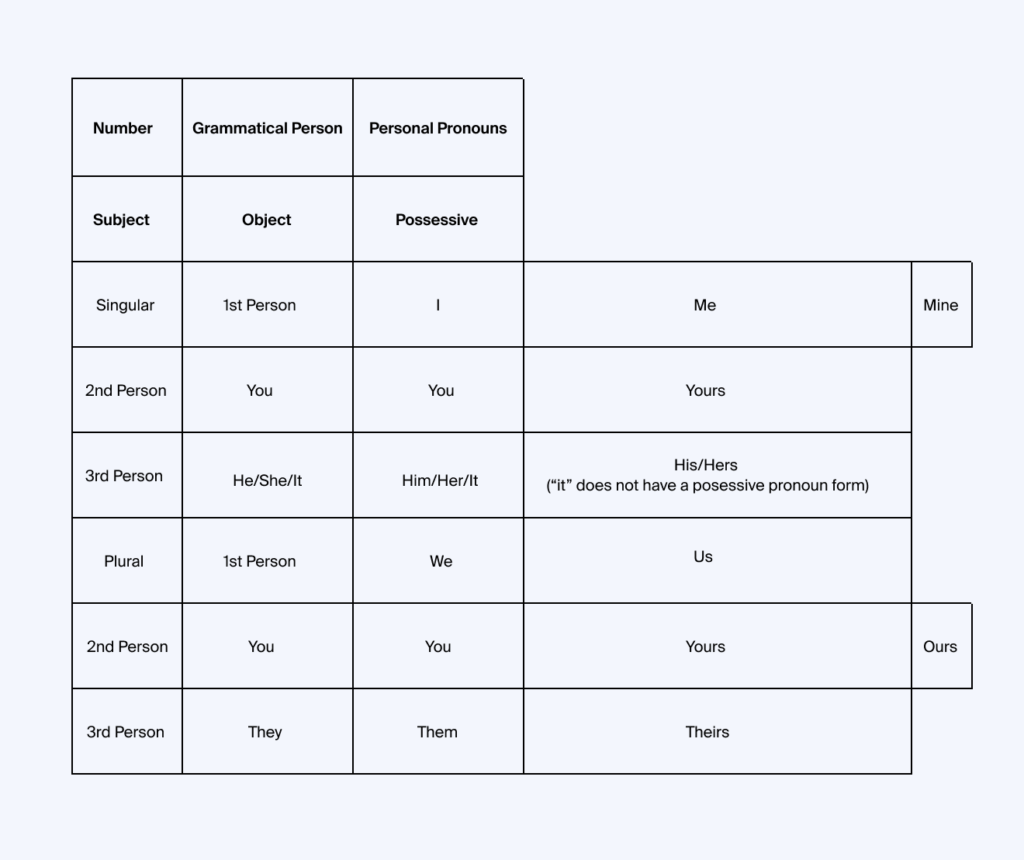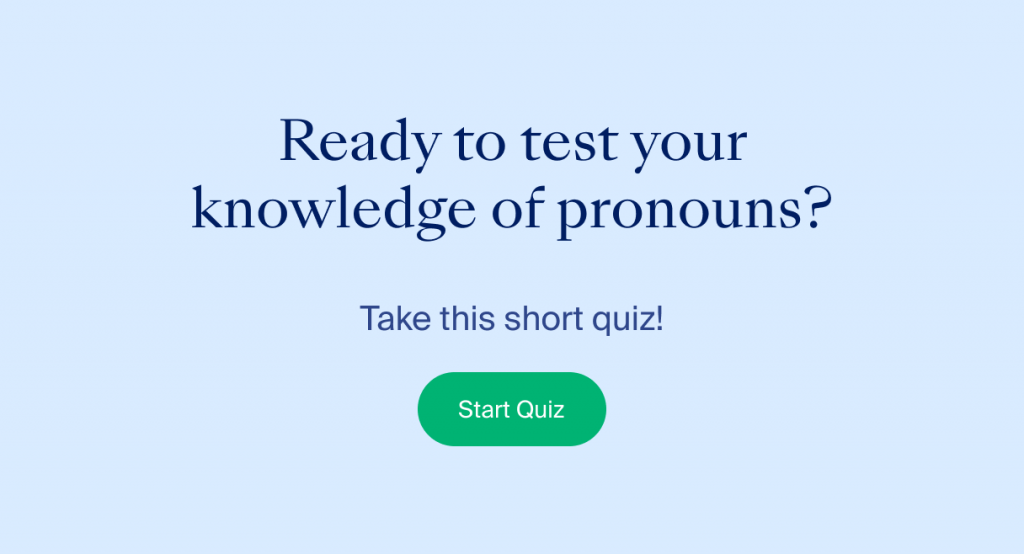
- 5-minute read
- 17th August 2020
Writing Tips: 8 Types of Pronoun
Pronouns are to language what screws are to flat pack furniture: they might seem insignificant at first, but without them everything else would fall apart.
That’s because pronouns can take the place of other nouns in a sentence, saving us from having to repeat the same words over and over. But the best term to use at any point depends on the situation, so you need to understand how different types of pronoun work.
1. Personal Pronouns
Personal pronouns are used in place of a specific person or thing.
There are different personal pronouns depending on whether we’re referring to the subject or object of a sentence, grammatical person, gender, and the number of things/people in question. There are also possessive forms of these pronouns used to indicate possession or ownership.

Make sure not to confuse possessive pronouns with possessive adjectives, though! The latter always modify a noun: e.g., you would say “It is my car” (adjective) or “The car is mine” (pronoun), not “It is mine car” or “The car is my.”
2. Demonstrative Pronouns
Demonstrative pronouns are used in place of particular things to show which one we’re discussing. For instance, in:
The words “that” and “this” each indicate specific things in relation to the speaker. “This” (plural = “these”) is used to refer to nearby things, while “that” (plural = “those”) refers to things far away.

3. Relative Pronouns
We use a relative pronoun when describing a noun in terms of how it relates to another word. For example:
In the above, “who” is a relative pronoun because it helps to show the relationship between the nouns “man” and “world,” thereby indicating that we’re referring to a specific person.

The main relative pronouns for referring to people are “who” (subject) and “whom” (object). The other key terms in this category are “which” (used for things) and “that” (used for either people or things).
4. Reciprocal Pronouns
Reciprocal pronouns express a mutual relationship or action. In English, we use “each other” and “one another” for this purpose. For instance:
Here, “each other” shows that the relationship between the nouns “Shirley” and “Jack” is reciprocal (i.e., it goes two ways). The alternative would be to write “Shirley looks after Jack and Jack looks after Shirley,” which makes it easy to see how important pronouns are for writing concisely!

5. Indefinite Pronouns
As the name suggests, indefinite pronouns are used when referring to something non-specific (e.g., “everyone” or “everything”) or something unknown (e.g., “someone” or “something”). They can be broken down into singular, plural and singular/plural pronouns:
Number | Examples |
Singular | another, anybody, anyone, anything, each, either, everybody, neither, nobody, no one, nothing, somebody |
Plural | both, few, many, others, several |
Singular/Plural | all, any, more, most, none, some, such |
Whether an indefinite pronoun is singular or plural determines the kind of verbs they are used with. For instance, in “each cake has a cherry on top,” we use the singular verb “has” to match the singular indefinite pronoun “each.” In “many cakes have cherries on top,” on the other hand, we use the plural verb “have” instead to fit with the plural pronoun.
Find this useful?
Subscribe to our newsletter and get writing tips from our editors straight to your inbox.
Indefinite pronouns also differ slightly from other pronouns in that they often replace other nouns completely rather than referring to a noun used previously (e.g., we don’t have to name every single person in a room before we can refer to them as “everybody in the room”).
6. Interrogative Pronouns
You’ll be glad to hear that interrogative pronouns are a little simpler. These are pronouns we use for asking questions, such as “who” or “what”:
We use “who” (subject), “whom” (object) and “whose” (possessive) when referring to people, while we can use “which” and “what” to ask questions about either people or things.
7. Reflexive Pronouns
Reflexive pronouns are used when the subject of a sentence is also the object of the sentence, such as in:
Here, “myself” is used as the object of the sentence (the thing that got punched) and refers back to the subject “I” (the thing doing the punching). Other reflexive pronouns include:
- Singular – myself, yourself, himself, herself, itself
- Plural – ourselves, yourselves, themselves
As you can see, these terms are formed by adding “-self” (singular) or “-selves” (plural) to a possessive adjective.
8. Intensive Pronouns
Intensive pronouns are actually the same words as reflexive pronouns but function differently. In this case, they add emphasis, like in the sentence:
Here, “herself” refers to the subject of the sentence (“she”) to stress that the achievement was hers alone. And as with the reflexive pronouns described above, intensive pronouns are formed by adding “-self” (singular) or “-selves” (plural) to a personal pronoun.
And there you go! Those are the different types of pronoun. If you still have difficulty knowing when to use specific terms, getting your work proofread is a great way of receiving feedback and enhancing your writing style.







